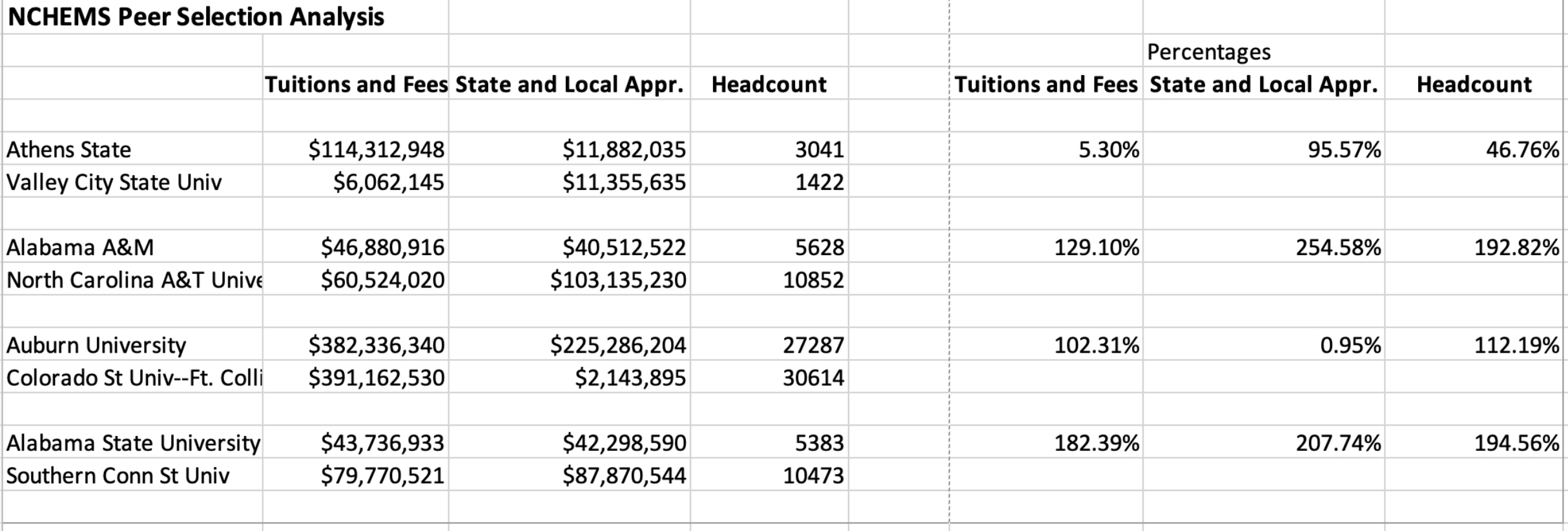Strident dissension erupted during the 2019 Legislative Session when it was discovered that a new methodology adopted by the Alabama Commission on Higher Education (ACHE) led to Auburn University being short-changed in the budgeting process.
ACHE Executive Director Dr. Jim Purcell who holds a doctorate from the University of Alabama tried to explain away why Auburn University received a significantly reduced percentage of state funding, but what he did not reveal were his close ties to the company who had recommended the cuts or allegations of misdeeds against the organization.
What is also seemingly apparent is the use of questionable data comparisons between nationwide institutions and Alabama’s schools of higher learning to determine funding allocations for the state’s colleges and universities in fiscal year 2020.
Purcell Hires NCHEMS
Colorado-based vendor, the National Center for Higher Education Management Systems (NCHEMS) was hired by Purcell to conduct statistical peer equity adjustments for each public institution, which dramatically lowered Auburn’s percentage of state funding for fiscal year 2020.
In other words, ACHE hired NCHEMS to compare Alabama’s universities and colleges to like institutions around the nation and on those findings recommend a budget to the Legislature. But a review of the process appears to show inequities in the methodology.
The review by NCHEMS resulted in Auburn receiving an increase of five percent, while the University of Alabama’s was more than 7.5 percent and Athens State University received the most significant increase at more than 11 percent.
The funding disparity led to rare public feuding between lawmakers, education leaders and others.
While the budget issue was eventually resolved, lingering questions about the process remain.
Records going back to 2003, suggest this was the first time ACHE had used this type of peer review formulation to determine funding recommendations for state colleges and universities.
Purcell’s Ties to NCHEMS
Purcell was named Alabama’s State Higher Education Executive Officer in April 2017, previously having served in similar capacities in Rhode Island, Louisiana and Arkansas.
During his tenure at these agencies, Purcell contracted NCHEMS, the same group who performed Alabama’s peer equity review for various projects.
NCHEMS is a vendor Purcell repeatedly hired as he moved from state to state holding jobs in higher education.
Public records show Purcell accepted money from groups with close ties to NCHEMS. These financial ties can be seen in Purcell’s state disclosure forms.
While serving in higher education roles in the states of Arkansas and Louisiana, Purcell received money from NCHEMS’ associates.
NCHEMS is located at 3035 Center Green Drive, Plaza 2 in Boulder, Colorado. Also, in the same building, is the Western Interstate Commission for Higher Education (WICHE) that states on its website, “WICHE played a leading role in the creation of NCHEMS.” A third group, the State Higher Education Executive Officers (SHEEO) is also housed in the same location.
In 2008, NCHEMS produced a study entitled “Adult Learning in Focus.” Purcell is listed as an advisor to the study.
In 2010, while working as the State Higher Education Executive Officer with the Louisiana Board of Regents, and as the leader of the Arkansas Department of Higher Education, Purcell reported income from WICHE, the group that helped create NCHEMS.
In 2012, while working in Louisiana, Purcell reported travel compensation from SHEEO.
Creating Fake Information in Nevada
In 2016, it was revealed that NCHEMS conspired with the Nevada System of Higher Education (NSHE) and its Chancellor, Dan Klaich, to prepare a fake document designed to mislead members of the Nevada Legislature.
According to an investigative report by The Nevada Review-Journal, “Nevada System of Higher Education officials actively worked to undermine the Legislature’s effort to overhaul college and university funding models…going so far as to present a false document to lawmakers and joking about it afterward.”
Emails show Nevada higher ed agency misled Legislature on funding study
During the episode, NCHEMS allowed NSHE to write a memo under the NCHEMS letterhead. As the Review-Journal wrote, “The memo was styled as the think tank’s response to questions raised by the committee and it directed Klaich to share the response with the committee.” Emails obtained by the Review-Journal shows that NCHEMS provided the stationary, and Klaich and NSHE filled in the blanks.
Klaich resigned after it was revealed he had presented a memo to the Nevada Legislature which was written by NSHE staff and put on NCHEMS letterhead – with the blessing of both Klaich and NCHEMS President Dennis Jones. Further, the Review-Journal printed email excerpts that showed NCHEMS and Klaich had colluded in misleading the Legislature.
Committee members were told that NCHEMS was an impartial consultant, when in fact the NSHE was working hand-in-glove with NCHEMS to create biased information for the Legislature jointly.
Despite his previous ties to NCHEMS and the allegations in Nevada, Purcell brought NCHEMS to Alabama.
Questions Emerges in Arkansas
Purcell led the Arkansas Department of Higher Education from December 2007, to February 2011. Numerous media reports note that the Department of Higher Education used NCHEMS during Purcell’s tenure.
A 2011 Arkansas Times story notes that Purcell paid NCHEMS $15,000 for a report for the state and the University of Arkansas chancellor criticized it.
G. David Gearhart, chancellor of the University of Arkansas at Fayetteville, as reported by the Times said, “the study looks like a put-up job, conclusions favored by DHE arrived at in advance.” Gearhart, “also said the consultants used incorrect data, making UAF look worse in comparison with similar research institutions in other states in producing graduates. And he told the Times that both the consultants and the director of DHE, Jim Purcell, had made statements in connection with the study that were unconscionably untrue.”
Peer Review Shows Inequities
NCHEMS’ higher education funding formula and use of peer groups created markedly different results in 2019, for some schools – results that differed dramatically from the funding formulas previously used in Alabama for decades.
The NCHEMS peer groups were meant to assess whether a specific university was being funded on a level that is competitive and comparable to similar publicly-funded universities across the country.
For each Alabama institution, NCHEMS provided a set of 10-15 peer universities to ACHE. No Alabama university was in another’s peer group. If a specific state institution was not shown to be funded to at least 90 percent of the average of its relative peer group, ACHE would recommend an additional funding adjustment on top of the standard adjustment recommended for all universities in the state.
In an analysis of the reports, some glaring inconsistencies in peer selection criteria stand out. The reports were based upon the performance of a given university/college in comparison to a group of nationwide peers selected by NCHEMS. Performances were averaged among the peers and measured back to the selected Alabama university/college. In an analysis of tuitions and fees, state and local appropriations and non-operating grants, and total number of students, some of the averages appear to be skewed by including other peers that are far superior or inferior to the Alabama institution.
Examples of comparisons
A comparison of Athens State and Valley City State University in North Dakota, shows appropriations are within 5 percent, however, Athens tuition receipts are 95 percent higher than Valley, and it has 53 percent more students.
When Alabama A&M is compared to North Carolina A&T University, A&T’s tuition budget is 1.29 percent higher, its state appropriations are 2.5 percent higher, but it has almost twice as many students.
In the case of Auburn University, in comparison to Colorado State University—Ft. Collins, the tuitions and students are comparable, however, state and local appropriations represent less than one percent of Auburn’s appropriations.
Looking at Alabama State University and Southern Connecticut State University, Connecticut’s tuitions, appropriations and total students exceed ASU by almost double in all three categories.
Colorado School of Mines appears in comparison to the University of Alabama—Huntsville. While the headcount is close, Colorado’s tuitions are nearly double UAH while their state and local appropriations only represent 6.45 percent of what UAH receives.
Athens State, Jacksonville State and Troy University peers included university/colleges that receive zero state and local funding, dramatically affecting the average.
While most reports appear to be using different universities/colleges in each analysis, Texas International A&M University is used as a peer in the three reports: Auburn University—Montgomery, Jacksonville State University and the University of North Alabama. The financial line items for all three are identical.
This pattern continues throughout the reports:
Delta State University appears as a peer in both the University of Montevallo and Auburn University—Montgomery.
Southern Mississippi is on both University of Alabama and University of Alabama—Huntsville report.
Georgia College and State University are on the University of North Alabama, Jacksonville State University and Alabama State University comparison.
Southern Oregon appears on Montvallo and University of West Alabama Reports.
More than ten other university/colleges were used for the same sort of baseline in other comparisons.
Further information on all university/college reports and summaries can be found at this link.
In Conclusion
Due to the proprietary nature of NCHEMS process, the methodology used to determine these peer groups is publicly unknowable. Ultimately, the methodology for choosing these peer groups – which determines the funding recommendation by ACHE to the Legislature – is a secret, to those who have a vested interest in the data’s accuracy.
A basic statistical analysis of the variation in state appropriation levels within specific peer groups for each university shows apparent inequity when comparing the groups to each other.
A set of peer groups that are fair and equitable should have reasonably similar statistical properties — this is not the case for the peer groups provided by NCHEMS.
Most of the universities’ peer groups have very similar levels of variation in state funding, but a few do stand out from the group. In short, how NCHEMS selected their peer groups gave a significant advantage to some universities. Other universities received no adjustment related to the NCHEMS peer groups.
Anomalies in the statistical peer equity adjustments overseen by NCHEMS led to a heated controversy during the 2019 Legislative Session. Lawmakers, as well as administrators, have expressed a desire to avoid problems going forward.





















































